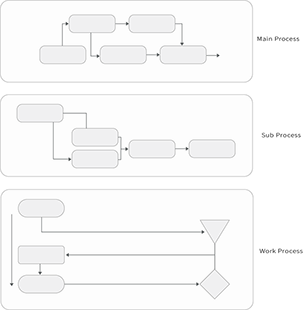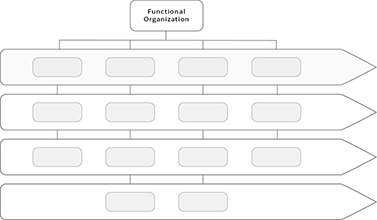Glossary
BUSINESS PROCESSES,METHOD & TRANSFORMATION
Logout
©Copyright Arcturus 2022, All Rights Reserved.
7
Terms & Conditions
|
|
|
|
Security & Privacy
Contact
Adopting correct process method companies can very quickly realise the benefits from achieving breakthroughs in their business performance, as perceived by their customers and other stake-holders.
A functionally biased organisation is inherently less efficient (with a direct correlation to its physical operational size) than those with dynamic multidisciplinary approach. Better co-operation across functional and geographical barriers is often needed to realise the benefits. This in turn can be fulfilled by the introduction of an additional organizational framework: the process organisation. The process organisation needs to be systematically structured, planned, controlled and led. It is therefore a management task to introduce and manage this new organisational dimension: Process Management.
Process Management is without doubt a critical success factor. Without structured method and Process Management, objectives will simply not be achieved. Process Management is the method by which the voice of the customer can make itself heard in every part of our business. Without method and clearly defined processes, Implementation of a business transformation programme is understandably a major challenge for all managers concerned.
Definitions:
Process ethos:
A cultural setting with the objective to focus on the way a business produces value for the customer and other stake-holders. A process ethos stimulates individuals to experience their work as part of a process and enables them to contribute to the improvement of the result of the process.
Method and Process:
A stream of activities transforming input into output by adding value.
Process Management: An organisational, managerial and instrumental framework for aligning all members of the organisation and their activities with processes.
What is a Process?
A process is a chain of events. A transformation takes place at every event or process step. This may be a transformation of material into material, of information into a decision or of energy into action. In each process, input is provided by a supplier and output is delivered to a customer. Every activity of a process should add value to the preceding stage, ultimately leading to the satisfaction of an external customer or other stake-holders.
The capabilities of different individuals and the resources of different departments are linked together by processes to produce joint value for the customer of the process.
Some processes are clearly visible as streams of material: production processes and physical distribution processes are well-known examples and can be readily observed. In other processes the streams are mainly flows of information.
These processes are not so easily visible. But they may be equally important.
Customers expect ever higher quality AND ever faster response AND ever lower costs AND ever better service AND ever higher flexibility.
The functional organisation is designed to offer customers ONE of these rather than ALL. There is a competitive edge to be gained by the organisation that does all things better and achieves the best all the time, every time.
Main processes are processes which run across large parts of a business organization. Two types of main processes are distinguished: business processes and support processes.
Main processes are the arteries of a business organisation.
Business processes produce value for external customers and other stake-holders.
Support processes create conditions for the functioning of business processes. They have internal customers.
Business Process
• Technology creation process
• Product/service creation process
• Market creation process
• Supply to sales process
• Customer support process
• Investor relations process
Support Processes
• Business planning and review process
• Human Resource planning, development and review process
• Financial planning, monitoring and review process Infrastructure planning and review process
Process Structure
Main processes contain a network of sub-processes, which in turn are assemblies of work processes. It is in a work process that the actual transformation of material, energy and information takes place.
It is important that the process structure is made visible and clearly understood. It is an activity comparable with drawing an organisation chart. This enables communication and decision making on priorities and actions for improvement.
The process structure can be made visible in further detail depending upon the organizational level at which process management is discussed. At the level of the work processes the link is made with individual activities. It is like applying a magnifying glass to every level of the process structure.
Why Process Management…
In deciding upon priorities for improvement, processes must be ranked. Key processes are critical for success. These can be key business processes, key support processes, key sub-processes and key work processes.
To build and retain a competitive edge, businesses have focused on specialization. This was introduced and safeguarded through the establishment of a functional organisation.
Most of the improvement activity was designed by and implemented through the functional structure. This has been a successful approach but, in many cases, the opportunities for further improvement along the functional dimension are limited.
Also, opportunities which demand a cross-functional approach remain largely unused. The boundaries between functions are increasingly perceived as barriers which inhibit the growth towards a customer oriented organisation.
The functional organisation has proven its value, but its disadvantage’s and shortcomings are more visible than ever before.
An additional approach is needed.
What is needed is an organisational formula that helps to increase the customer perception of value. Process Management offers this. At the same time, it allows the company to become more successful by eliminating waste inherent to the functional organisation.
Process Management
Process Management adds a dimension to Functional Management. Process Management is owned, introduced and driven by the management team. Process Management consists of several, interlinked components.
Process control and process maintenance form the basis for process management. Process control is the systematic evaluation of the performance of a process and the corrective actions taken if performance does not conform to standards.
Process maintenance assures the repeatability of processes per standards and procedures.
Continuous process improvement is gradually but continuously improving process capabilities. Process improvement is stimulated and facilitated by management but everyone participates. Process design and process redesign are projects aimed at establishing process capabilities. These are the result of an innovation activity, in addition to continuous improvement. The objective of redesign / re-engineering is to achieve a breakthrough in process performance. Implementing a Process Culture aims at making the process way an important element of the prevailing attitude and behaviour of all people in the organization.
Process management...
...focuses processes on business priorities...
• by deploying business priorities into objectives for controlling, improving and (re)designing processes...
• by analysing the process structure and improving insight into cause and effect relationships...
• by establishing ownership for process control, improvement and (re)design and stimulating the allocation of resources...
• Process Management establishes an environment in which the PROCESS WAY leads directly to competitive advantage as perceived by customers.
...focuses people on processes...
• by making processes visible...
• by making the process structure manifest...
• by providing a framework for understanding how a business provides value to customers...
• by linking the contribution of people to the improvement of processes which create value for the customer...
• by determining and explaining priorities of the various processes...
• by encouraging people to add the process dimension to their functional orientation through involvement in process-directed activities...
Implementation
The implementation of Process Management requires a new attitude and new capabilities from managers.
First they need to demonstrate understanding of what processes are and what process management means for customer satisfaction and hence business success. Then they must explain why the functional organisation is still needed but is no longer sufficient to achieve the necessary improvements. Next they must teach the principles of process management, illustrate its characteristics and application through the demonstration of case material or own examples and coach people through the first steps of implementing Process Management in daily work.
The management of a process
It is necessary to add a process-oriented management structure to the existing functional organisation. Individual managers have the specific task to own one or more processes, starting at the level of main processes and moving all the way down to the work processes. Ownership implies that managers accept, in addition to their existing task, the responsibility for an entire process across all functional barriers.
It is the task of the process owners to make the process visible (mapping), to agree on the performance targets for the process (policy deployment), to measure the actual performance of the process (performance monitoring) and to take measures to improve process performance if necessary.
The appointment of process owners for all main, sub, and work processes results in a structure of process owners superimposed on the functional hierarchy.
Process Control and Improvement
Most organisations have capabilities for process control and maintenance. Tools and methods for their implementation and for the supervision of their effectiveness are provided by the Quality Control & Assurance function, supported by Quality systems and standards such as ISO 9000. Statistical Process Control (SPC) is one of the well-known tools for process control in many areas.
Continuous process improvement
Most continuous process improvements are undertaken by quality improvement teams. Different types of teams exist. Some have a departmental nature, others have members from a variety of functions (cross functional teams). Many improvement actions, if added up, may lead to impressive total process performance progression.
It is by now understood that if process improvement is demanded, rather than activity improvement, teams with a multi-functional composition are required. Improvement teams use the PDCA (Plan-Do-Check-Act) cycle.
Many tools are available for continuous process improvement. Well known, although still insufficiently applied, are the seven statistical tools, the seven management tools, tools to prevent problems (like FMEA; Failure Mode and Effect Analysis) and tools to make processes visible and open to analysis (like flowcharting and bottleneck analysis).
Business Transformation
Some of the Business Processes and Support Processes have been intentionally designed. This certainly is the case for physical processes like production and physical distribution. There are also examples in the field of information systems where process design is a phase in the development activity. Many of these cases are in the logistics area.
The Product Creation Process (PCP) has often been intentionally designed and/or redesigned to achieve improvements in process performance. For example, the process cycle time will be drastically reduced and is better controlled.
But many of the Business and Support Processes have developed over a period and have not been deliberately designed. Many of these processes are not visible; neither are they explicitly managed. Responsibilities for process design, monitoring, evaluation, improvement, and redesign have not been defined.
The competitive advantage which is aimed at cannot be achieved without clearly defined ownership of improvement, design and redesign of Business and Support Processes.
As many of the existing processes do not perform at a world- class level - and hence do not lead to competitive performance in the perception of customers and other stake-holders - there is sometimes a real need for large-scale redesign.
Process Redesign
Process redesign can be divided into three phases: discovering the needs and opportunities, the actual redesign, and the implementation.
Discovering the needs, opportunities and conditions
This phase aims at identifying the key processes in a business organization, assessing needs and opportunities for improvement, and selecting specific processes for redesign. The definition of redesign objectives is the result of Policy Deployment.
The management team takes the following steps:
Agree on critical success factors
Understanding which success factors drive competitive advantage in the business. Examples of critical success factors are: lead time to market, speed and reliability of supply and life-time costs. Using Policy Deployment, the critical success factors and their relationship with Business Processes can be defined.
Identify key processes
Determining which Business Processes have the highest impact on the desired business performance. These are the key processes. Key processes have the highest priority in redesign. There may also be other reasons such as malfunctioning or inconsistency which lead to a high priority for redesign.
Prepare for change
Appointing one of the management team members as owner for each process to be redesigned. The owner has the authority to act on behalf of the team and reports to that team.
The Management Team decides which other conditions, including elements of behavioural change, they need to address to make the redesign a success.
Assess the opportunities for breakthrough
As business process performance improves, so does the customers’ perception of value. Competitors also continuously improve their processes. Generally, there will be a definable performance level - measured in cost, product quality, service or cycle time - that will lead to a disproportionate gain in competitive advantage. This is the breakthrough level.
An important tool for identifying breakthrough opportunities and facilitating implementation is benchmarking. It implies searching and studying world-class processes in other industries. It is also vital to establish a clear understanding of an agreement upon customer needs and perceptions.
Summary
Focus on value for the customer
Process management helps to focus attention of all members of the organization on value for customers and the business processes which create that value. At the same time it supports the identification and elimination of waste.
Focus on processes, not functions.
The processes which create value for customers cut across the interfaces between functions. Interfaces may be barriers for improvement. Process management creates a new dimension in addition to the functional division of tasks and responsibilities.
Focus on the people who must make it happen.
Process management implies organization-wide change.
The success depends first on the people who are involved. It is a management task to explain, train, coach and be involved and thus stimulate people to participate fully.
Focus on all processes.
Process management addresses the whole process dimension, even if there is a priority for the redesign of key business processes. The basis for process management is continuous improvement of all processes, in which all people must be involved, as well as relevant business partners.
Focus on stretching targets.
Stretching targets force the organization to change the way it thinks and acts. Only stretching targets will enable us to surpass the performance of competitors and to be perceived by customers as the best.











